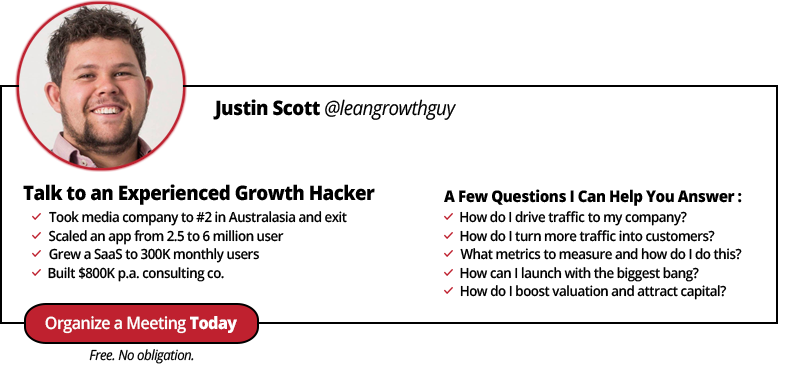There are new startups being launched every day, and business owners are finding that their key to success doesn’t lie solely in the merit of their idea or quality of their product but in the ability to attract customers.
Thus, people are turning to growth hacking – a method of marketing where companies analyze who is using their product and how, and then relentlessly pursue growth using that knowledge.
The ultimate outcome in growth hacking is that your product will eventually market itself, without extra time or money invested by you. Want to know more about ways you can use growth hacking to grow your new startup?
Here are 10 useful tips to attract new users and get those new users to attract even more new users.
Use Built-In Sharing
One of the most important ways to use growth hacks to grow your small startup is by incorporating sharing into its functionality. Sharing means that your content can be directly linked to on social media platforms, allowing your users to do the work of marketing for you.
When people endorse something via social media, they are recommending it to their friends, upping the chances that someone new will discover and check out your page or product. One company that implements this growth hacking strategy very successfully is Pinterest.
Pinterest allows users to find content on the site and share it with one click of a button, whether it’s to their own Pinterest page or to Facebook or Twitter. Not only does Pinterest have many ways to share built in, it also makes sharing easy and straightforward, and people don’t have to do a lot of work to make it happen.
If you want to use sharing to growth hack, make sure you let people distribute content to their social media pages easily; the less work users have to do, the more likely they will do it and the more likely you will be able to take advantage of some free marketing.
Incentivize Distribution
Since you want people to share your site, it may encourage people to share if you offer them some incentive. One example of incentivized distribution is called “forced virality,†which means that a person can’t access a certain part of your site or product until they’ve shared it. Or, you can give your users something nice if they do something extra for you, like a discount if they choose to e-mail friends or additional services if they post about you on a social media platform.
One good example of a company that implemented this tactic to grow successfully is Dropbox.
Under the direction of legendary growth hacker Sean Ellis, Dropbox awarded extra free storage space to any user who shared the site with friends, encouraging more people to engage with the site. Incentivizing distribution is just an extra push to get people talking about the site and, in turn, get new people discovering it.
Encourage Sharing on Your Actual Product
If your company makes a product, one great way to help spread its popularity is to incorporate a mechanism into the product to encourage sharing it or to create a companion product that spurs distribution. For example, Moo, a business card company, includes a card in every pack of business cards that encourages people to “Pass It On,†with a discount and a game.
Hotmail also used a similar tactic; they included a P.S. line in every Hotmail that said, “P.S. Get your free e-mail at Hotmail,†sending a message to everyone who receives a Hotmail e-mail that they should sign up as well. Incorporating such a mechanism serves as a physical reminder for people to spread the word about your product, and it naturally attracts potential customers.
Tap into Places Where Potential Customers Might Congregate
One of the most important ways to discover new users is by finding the right audience and where they hang out online. You don’t want to waste time marketing to people who won’t actually like whatever your company does or makes.
If you advertise in the right place, you’ll not only target the appropriate audience, but you’ll also reach the audience’s friends, who may also like your product. One example of a company employing this strategy is Airbnb, who went to Craigslist to find their first customers.
They knew people using Craigslist were looking for places to stay, so they offered a cheaper, safer and easier version of what everyone there was already looking for.Do some research about what places your target audience frequents online, then spend your time, resources and energy spreading the word there.
Offer Free Products that Go Well with Paid Products
One of the best ways to convert a potential customer to a paying customer is to offer free services or products, as well as products for purchase. The products you offer should go well together, so that when people sign up or receive your free product, they’ll also want to pay for the priced product.
Moz does this well with their SEO services. You can sign up on Moz to receive a ton of free SEO tools, advice and information. However, you have to pay for their premium SEO service. The thinking behind Moz’s strategy is that people will be so impressed by the free info that they’ll be willing to pay for even better info.
Consider offering different levels on your site, the free, basic part to attract people, and then a paid version for people once they’ve already joined. The free offer is a great way to bring more people in, and the paid offer is an excellent way to bump people up to paying customers.
Piggyback
One of the best ways to grow your startup quickly and easily is to piggyback on a company that already exists and has tons of users. If you’ve created a service that goes well with an existing service or site, it makes sense to appeal to the already existing customer base.
Perhaps the most famous example of this technique is PayPal and eBay. eBay was already in existence when PayPal started up, and the way that the online payment company grew so quickly is that it appealed to eBay buyers who were looking for a safe, fast and easy way to send money to vendors. As eBay grew, so did PayPal because they were able to reach users of one service who needed the service of the other.
Partner
If you don’t want to just piggyback onto the back of a company, a partnership can also be a great way to attract new users.
Partnering with a company gives you free marketing to the group that they’re attracting, in exchange for you marketing their product or service in some way. There will be financial incentives involved in partnering with a company, so make sure you negotiate what those will be.
You can offer a share of your revenue in exchange for finding and sending you prospects. You can also offer to build a product or service for their site in exchange for potential customers, and vice versa.
Get Endorsed
If you want your company to grow virally, a great way to do it is to get endorsed by someone whom the public loves and trusts. Endorsements are a paid relationship between your company and a celebrity or well-known expert who endorses your product, writes about it on a blog or social media platform, or even makes ads for it.
Celebrities and thought-leaders tend to have other important friends, so when they share and talk about your product, chances are other influential people will be attracted to it and talk about it, resulting in multiple celebrity endorsements and a huge amount of encouragement for everyday people to check out your company.
Reward Power Users
Growth hacking isn’t all about attracting users. It’s also about keeping the ones you already have. The best salespeople for a company are the people who love, support, and use it. So, if you have longtime or frequent users, reward them with deals, meetups or special offers.
Retaining your best customers is important, and the happier they remain with the site or service, the more likely they are to continue to preach its goodness to the world.
Make a Great Product and Listen to Feedback
Despite all the tricks you can try to hack the growth of your company, at the end of the day, the most important thing you can do is to make a really great product. If you have something that you believe in and have worked hard to perfect, chances are you’re going to find people out there who feel the same way. It’s important to ask for feedback from customers, too, to see how they experienced your company and how they would improve it.
Don’t ignore this feedback. It’s essential to keep your company evolving and making the product better and better because a really great product will eventually just market itself.


